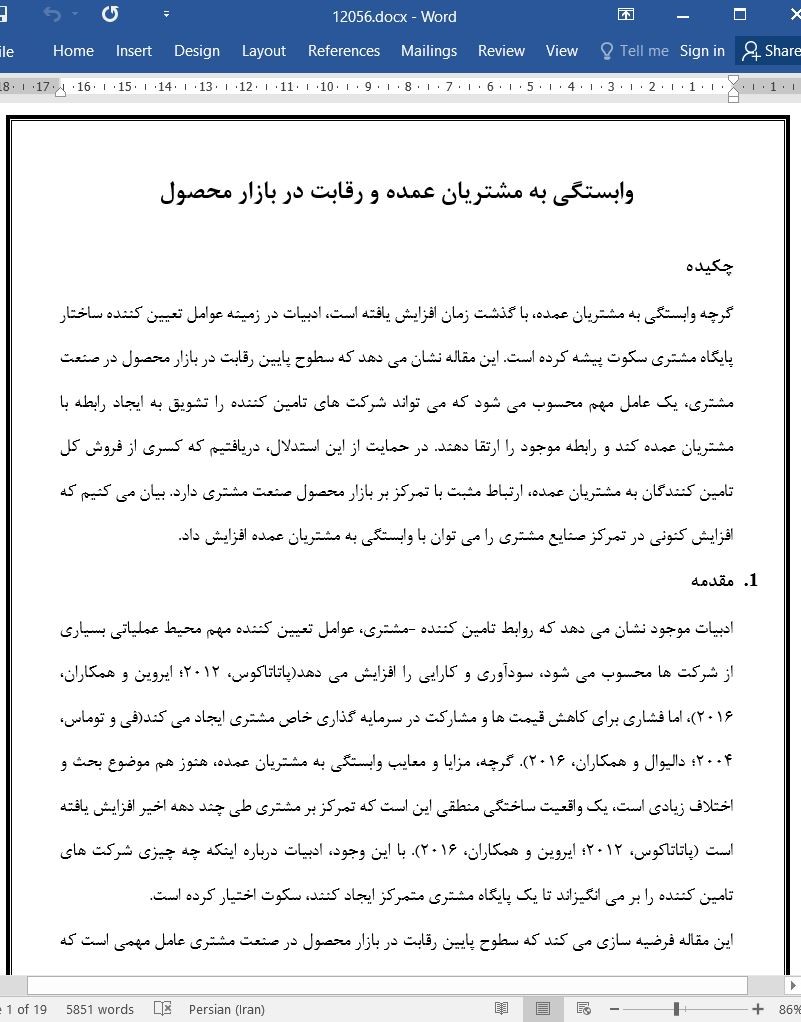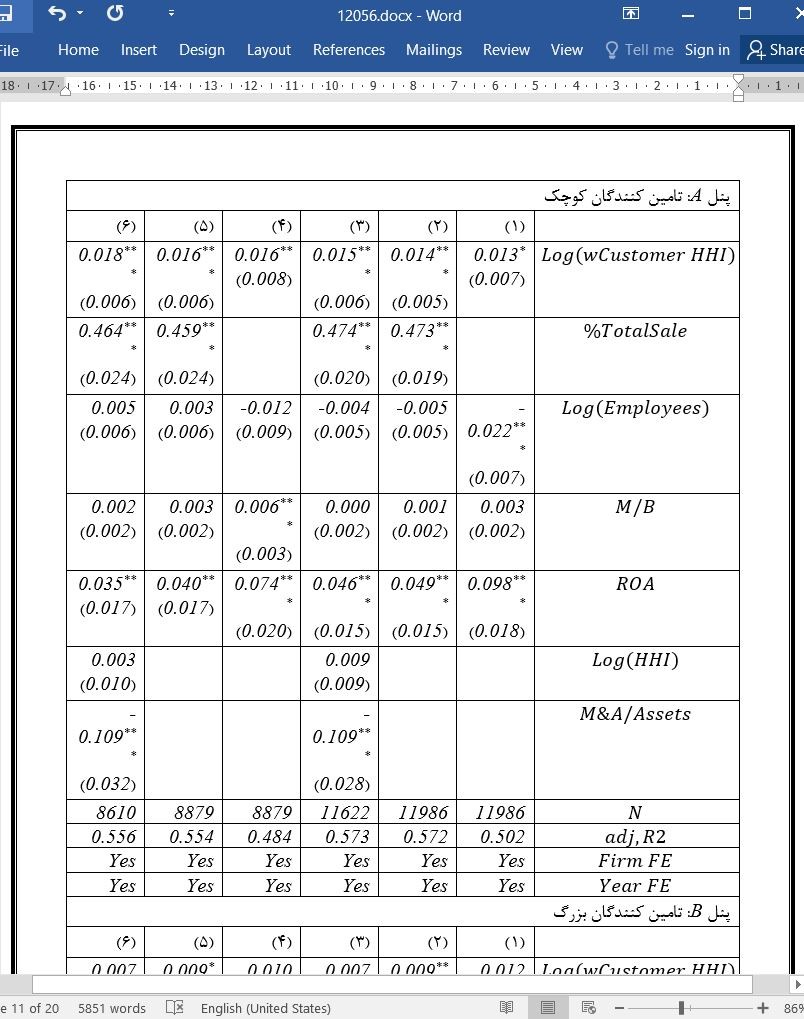
وابستگی به مشتریان عمده و رقابت در بازار محصول
چکیده
گرچه وابستگی به مشتریان عمده، با گذشت زمان افزایش یافته است، ادبیات در زمینه عوامل تعیین کننده ساختار پایگاه مشتری سکوت پیشه کرده است. این مقاله نشان می دهد که سطوح پایین رقابت در بازار محصول در صنعت مشتری، یک عامل مهم محسوب می شود که می تواند شرکت های تامین کننده را تشویق به ایجاد رابطه با مشتریان عمده کند و رابطه موجود را ارتقا دهند. در حمایت از این استدلال، دریافتیم که کسری از فروش کل تامین کنندگان به مشتریان عمده، ارتباط مثبت با تمرکز بر بازار محصول صنعت مشتری دارد. بیان می کنیم که افزایش کنونی در تمرکز صنایع مشتری را می توان با وابستگی به مشتریان عمده افزایش داد.
1. مقدمه
ادبیات موجود نشان می دهد که روابط تامین کننده -مشتری، عوامل تعیین کننده مهم محیط عملیاتی بسیاری از شرکت ها محسوب می شود، سودآوری و کارایی را افزایش می دهد(پاتاتاکوس، 2012؛ ایروین و همکاران، 2016)، اما فشاری برای کاهش قیمت ها و مشارکت در سرمایه گذاری خاص مشتری ایجاد می کند(فی و توماس، 2004؛ دالیوال و همکاران، 2016). گرچه، مزایا و معایب وابستگی به مشتریان عمده، هنوز هم موضوع بحث و اختلاف زیادی است، یک واقعیت ساختگی منطقی این است که تمرکز بر مشتری طی چند دهه اخیر افزایش یافته است (پاتاتاکوس، 2012؛ ایروین و همکاران، 2016). با این وجود، ادبیات درباره اینکه چه چیزی شرکت های تامین کننده را بر می انگیزاند تا یک پایگاه مشتری متمرکز ایجاد کنند، سکوت اختیار کرده است.
5. نتیجه گیری
این مطالعه به بررسی تاثیر ساختار بازار صنعت مشتری بر روابط زنجیره تامین می پردازد. پیش بینی می کنیم که اتکا به مشتریان عمده در شرکت هایی که فروششان به مشتریانی است که در محیط با رقابت کم در بازار محصول فعالیت می کنند، چشمگیرتر است. با استفاده از شاخص HHI صنعت مشتری با فروش موزون، نشان می دهیم زمانی که رقابت مشتری پایین است، تامین کنندگان شبکه مشتری خود را با فروش به پایگاه مشتری کمتر پراکنده، متراکم می کنند. سایر آزمون ها مطابق فرضیه های اصلی ما بود.
Abstract
Although reliance on major customers has been growing over time, the literature has been largely silent on the determinants of customer base structure. This paper shows that low levels of product market competition in the customer industry is one important factor that can encourage supplier firms to establish relationship with major customers, and enhance existing ones. In support of the argument, we find that the fraction of suppliers’ total sales to major customers is positively associated with customer industry product market concentration. We argue that the recent increase in concentration of customer industries could have increased reliance on major customers.
1. Introduction
Existing literature demonstrates that customer-supplier links are important determinants of the operating environment for many firms, enhancing profitability and efficiency (Patatoukas, 2012; Irvine et al., 2016), but also creating pressure to reduce prices and engage in customer-specific investment (e.g., Fee and Thomas, 2004; Dhaliwal et al. 2016). Although the benefits and costs of reliance on major customers are still subject to a debate, a robust stylized fact is that customer concentration has grown over the past several decades (Patatoukas, 2012; Irvine et al., 2016). Yet, the literature has been largely silent on what motivates supplier firms to form a concentrated customer base.
5. Conclusion
This study explores the impact of customer industry market structure on supply-chain links. We predict that the reliance on major customers is more pronounced in firms that sell to customers operating in the environment of low product market competition. Using sales-weighted customer industry HHI index we show that when customer competition is low, suppliers condense their customer network by selling to a less disperse customer base. Other tests are also consistent with our main hypothesis.
چکیده
1. مقدمه
2. نمونه، داده و شرح متغیرهای اصلی
3. نتایج
4. بحث
5. نتیجه گیری
منابع
Abstract
1. Introduction
2. Sample, data, and main variables description
3. Results
4. Discussion
5. Conclusion
Acknowledment
Appendix B. Supplementary materials
Appendix A
References
- اصل مقاله انگلیسی با فرمت ورد (word) با قابلیت ویرایش
- ترجمه فارسی مقاله با فرمت ورد (word) با قابلیت ویرایش، بدون آرم سایت ای ترجمه
- ترجمه فارسی مقاله با فرمت pdf، بدون آرم سایت ای ترجمه



